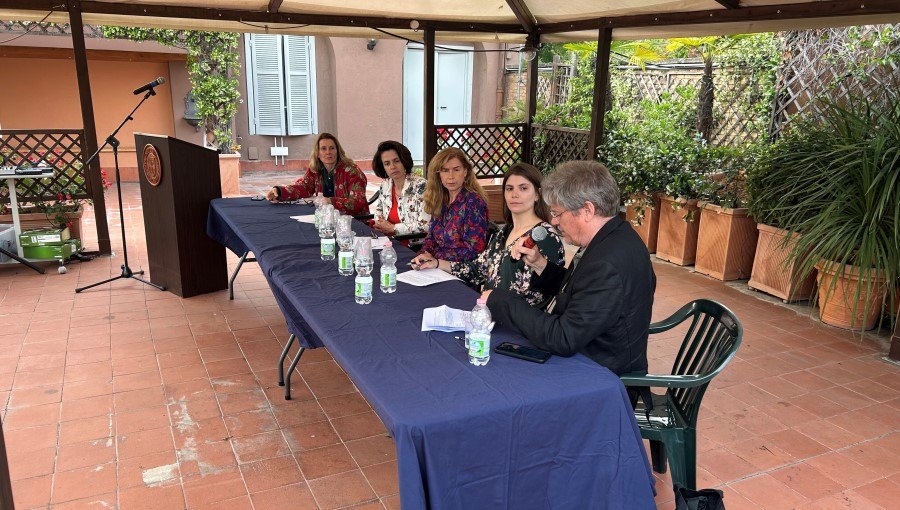Department of History and Humanities Sponsors Two-Day Event on Roman Magic
History Professors Fabrizio Conti (John Cabot University) and Elizabeth Ann Pollard (San Diego State University) are currently editing the volume There Is No One Who Does Not Fear To Be Spellbound: Magic in the Roman World (8th c. BCE – 5th c. CE), which will be published in 2021 by Trivent Publishing, Budapest (Hungary). The volume is part of the series Advances in the History of Magic, Witchcraft, and Religion, of which Professor Conti is the general editor and Professor Pollard is a board member. The book features contributions from scholars and professors as well as graduate and postgraduate students from around the world.
Professor Conti, Professor Pollard, and Dr. Teodora Artimon, Head of the Trivent Medieval Imprint, organized a two-day event sponsored by the JCU Department of History and Humanities called “Researching and Publishing Roman Magic: How an Academic Peer-Reviewed Volume Takes Shape,” held online on March 13 and 20, 2021. During the event, the volume contributors shared an overview of their papers.
Magic and Medicine in Pliny the Elder’s Naturalis Historia
Alfredo Viscomi, Latin Literature Professor at the Università Cattolica di Brescia, presented his paper “Magic to steal, magic to love, magic to heal: veneficia, defixiones, devotiones in the Naturalis Historia by Pliny the Elder.” Viscomi’s paper analyzes the theme of magic and medicine in the Naturalis Historia (AD 77) by Roman author Pliny the Elder (AD 23/24 – 79) by explaining that in ancient Roman times, esoteric practices and rituals were deeply ingrained in popular culture and beliefs.
Viscomi argues that Pliny’s ideas are at times ambiguous, because he mixes magic and medicine. In fact, on the one hand Pliny chastises magical practices as superstitious, while at times attributing medical powers to them, as was believed at the time. Pliny also differentiates between white and black magic, which were used for different purposes, hence blurring the boundary between science and medicine, and magic and occult practices.
Andrea Maraschi, Professor of Medieval History, and Social and Economic History at the Università di Bari, discussed his paper “A World Imbued with Sorcery? Magic in 4th- and 5th Century Christendom.” Since Christianity became the official religion of the Roman Empire in 380 AD, the 4th and 5th centuries were a period of transition from pagan to Christian times, so Maraschi chose to focus on the continuities between magic and religious practices. Maraschi explained that magic originated with a noble purpose, which was to address health problems that traditional medicine couldn’t cure. But with the rise of black magic, these practices started to have a bad reputation. With Christianity, magic was associated with, among other things, idolatry, potions, and murder.
In his paper, Maraschi analyzes the worldview of people who believed in the supernatural, be it religion or magic. Some theological works advance the idea that one cannot be a magician without establishing a contact with demons and corrupting his/her own soul. In fact, while the efficacy of magic is not denied, the prevalent idea at the time was that when in need of supernatural help, one should choose wisely and pick religion. So, both religion and magic resorted to the supernatural, which they believed was necessary to overcome the difficulties of life.
Cicero’s De Divinatione
Angelica Flandoli, master student at the Università Cattolica del Sacro Cuore in Milan, talked about her paper “Foreseeing the Future: the role of women between magic and divination.” Starting from Cicero’s De Divinatione (44 BC), Flandoli argues that in ancient Rome, the ability to know the future was connected to both magic and divination, albeit in different ways. Magic was considered amoral and illicit, and women had an active role in it. It was believed that they had secret knowledge and abilities that altered the cosmic order of things. Divination, on the other hand, was considered licit and thought of as a religious practice that used divine signs to predict the future for the collective good. Women in divination had a passive role, and they were granted protection from the gods, religion and society.
In his work, Cicero identifies two types of divination, namely, natural and technical. Dreams and visions are an example of natural divination, as is the diviner being possessed by the gods, creating a direct contact with the deities. Technical divination was based on natural signs that needed the interpretation of a priest. The two categories, however, overlapped at times, making it difficult to have a clear distinction between them. For example, even though dreams were considered natural divination, at times they needed to be interpreted by a priest because of people’s inability to understand them, blurring the line between the two types of divination.
Flandoli also discussed necromancy, or the practice of predicting the future through the summoning of the dead, who were believed to know every past, present, and future event. In ancient Rome, however, there were no official necromantic rites practiced. Cicero openly declared that he did not believe in necromancy and claimed that all those that practiced it were impostors.
Cumaean Sybil, Canidia, and Erichtho
In her paper, Flandoli takes into consideration three literary characters that are important for divination, namely, the Cumaean Sybil in Virgil’s Aeneid, Canidia in Horace’s Epodes, and Erichtho in Lucan’s Pharsalia. The Cumaean Sybil is an important figure because she is a unique example of a priestess performing necromancy. Her rite to open a door to the underworld is very similar to the one performed by Canidia, as they both dig a pit and pour blood in it to create a connection with the deities. They both call on Hecate, the goddess of magic and witchcraft, and when they manage to open the door to the underworld, supernatural phenomena occur.
Despite these similarities, there are also many differences between the two, the main ones being the fact that the Cumaean Sybil performs necromancy for a collective purpose and doesn’t go against the natural order of things, whereas Canidia does so for personal reasons or upon payment from someone else. Moreover, the Cumaean Sybil performs her ritual in a very meticulous way under Apollo’s temple, which grants her his protection, whereas Canidia does it furiously, in a graveyard, secretly, and at night.
Canidia is also similar to Lucan’s Erichtho, as one of their rituals involves forcing the soul of the dead to come back among the living. Erichtho, however, is more ruthless than Canidia, since she not only conjures the dead back to the world of the living, but she also reanimates their corpse. Furthermore, Erichtho believes she is superior to the gods, as shown by her promise to one of the souls she reanimated, to grant it an eternal rest that could not be broken by any spell, which she says the gods could not provide.
Yvette Hunt, Honorary Research Fellow at the University of Queensland, in Brisbane, Australia, talked about her paper “Pursuing Health by Pursuing Disease: the use of spells and amulets to address malaria in Roman antiquity.” At the time malaria especially difficult to treat, and magical amulets to heal and prevent it were popular. A 3rd century Latin medical text contained a Greek incantation used to dispel malaria by invoking the power of King Solomon. This is an example of how contemporary Greek magic was absorbed into Roman culture to deal with its identified diseases.
Hunt discussed the fact that magic, be in in the form of incantations or amulets, was the go-to treatment for malaria, which was associated with demons. She also discussed paper amulets, where specific incantations were written, and how they were believed to cure malaria. She also mentioned how amulets were supposed to be worn on different parts of the body, depending on their nature.
Curse tablets
Madeline Line, Ph.D., presented her paper “Cursing patterns and religious beliefs in Roman Britain,” which looks at curse tablets in Roman Britain. Out of 167 published tablets with curses written on them in Britain, 164 are judicial prayers, or curses that seek redress or revenge for something that has already taken place. The three remaining curse tablets are binding spells, which seek to diminish risk or gain an advantage in erotic spheres or any sort of competition, such as athletics. Line argues that the use of judicial prayers is reflective of a complex set of beliefs, particularly the fact that the gods could enforce moral behavior and could be called upon to do so.
Scarab amulets
Egyptologist Ronaldo Gurgel Pereira, researcher at the Universidade Nova de Lisboa, Portugal, discussed his paper “Magical gemstones: A Roman legacy of Phoenician, Greek, and Etruscan scarab amulets.” Pereira talks about the presence of various typologies of scarab amulets on Etruscan necropolises. Unlike other scarabs, the inscriptions on the Etruscan ones didn’t address women or children, but adult men who went to war and who were the main recipients of these amulets. In fact, the scarab amulets were mostly made of red stones, which were connected to the idea of blood and war.
Pereira also compared the iconography of Etruscan sarcophagi with scarab amulets and found some parallels between them. He shows that the scarabs are a summarized representation of the funerary iconology of the sarcophagi, with the idea of a successful warrior or of a spiritual being protecting him in battle always present in one way or another. Pereira then touched on the Roman appropriation of these Etruscan elements, attempting to build a connection between the two. He argues that a new dimension of syncretism developed as the Roman Empire expanded to the Eastern Mediterranean, and that Roman magical gems are an example of that.
Change and continuity
Charlotte Spence, a Ph.D. student at the University of Exeter in the United Kingdom, discussed her paper “Change and continuity in curse tablets and the Roman world.” Her paper looks at how the tradition of curse tablets changed across the geography and chronology of the Roman world, while also maintaining a sense of continuity across space and time.
The first part of Spence’s analysis focused on curse tablets produced in Rome between the 1st and 4th centuries A.D., whereas the second part looked at tablets from different Roman provinces such as Britannia, Carthage, and Germania, but all dating to the 2nd century. Among the questions that the paper seeks to answer are what impact magical handbooks had on the production of tablets, and if there was a shift from amateurs to professional magical practitioners.
Roman witches
Nicole Kimball, Ph.D. candidate at the University of Newcastle, Australia, presented her paper “Abjection and anxiety: the metamorphosis of the Roman literary witch.” Abjection is a psychoanalytic theory based on the idea of the separation between the self and everything else. The paper looks at the three types of witches in Rome. The first part looks at Ovid’s depiction of Circe and Medea, which were imported from Greek mythology. Kimball explains that in ancient Roman literature Circe and Medea become more abject than their Greek counterparts, and their characters become less complex because a lot of their motivation is taken away.

Circe Changing Picus into a Bird (Circes concubitum detestatur Picus), from Ovid’s ‘Metamorphoses’ by Antonio Tempesta
Kimball then looks at two types of “native” Roman witches, namely bawd witches and hag witches. The bawd witches were usually portrayed as “fun drunk old ladies” and surrounded by young girls whose bodily integrity they threatened, and who were steered away from their goals and plans in order to do what they wanted them to do. Not only are they a threat to other people’s bodily and mental integrity, they also don’t seem to have any of their own.
An example of hag witches would be Horace’s Canidia and Lucan’s Erichtho, who are a blend of the two previously discussed types of witches. Horace describes Canidia as pale and hideous to look at, since she resembles the ghosts that she’s trying to converse with. The concept of abjection here is represented by blurring human and animal elements, and living and dead bodies.
Lucan’s magic
Caolàn Mac An Aircinn, a Ph.D. student from the University of Texas at Austin, USA, talked about his paper “How Lucan Kills Magic. Magic and the vates in Book Six of Lucan’s Bellum Civile.” He argues that two apparently independent aspects of Lucan’s Erictho, when taken together, show how magic in Lucan’s world, and by extension poetry, can no longer produce truth.
The first of these aspects is the fact that when Erictho chooses a corpse through which to practice her necromancy, paradoxically she uses one from the Battle of Pharsalus, although it has not yet occurred. There remains no scholarly consensus as to how she can do this, despite numerous attempts. Meanwhile, in the rest of the book, both Erichto and the corpse through which she prophesies are described as vates, a word properly applied by this time to poets, and puzzling as a descriptor of a magic-user.
In contrast to previous scholarship, Mac An Aircinn argues that Lucan’s paradox is intentional and that in the Bellum Civile, poetry has become feeble and divested of the ability to convey truth, based on the inconsistencies which dog it. Also, he examines literary precedents ranging from Euripides to Horace to establish that Erictho’s is a poetic magic, based on the layered meaning of words such as carmen and vates used by Erictho. Mac An Aircinn suggests that the decline of poetry argued for is so profound that it has leeched even Erictho’s magic of its ability to speak truth.
The two-day paper presentations and discussions have been particularly fruitful, both in shaping a new volume on Roman magic and in creating an opportunity for students to enter a laboratory of research and publishing, which is the core and the outcome of any humanistic intellectual endeavors.








